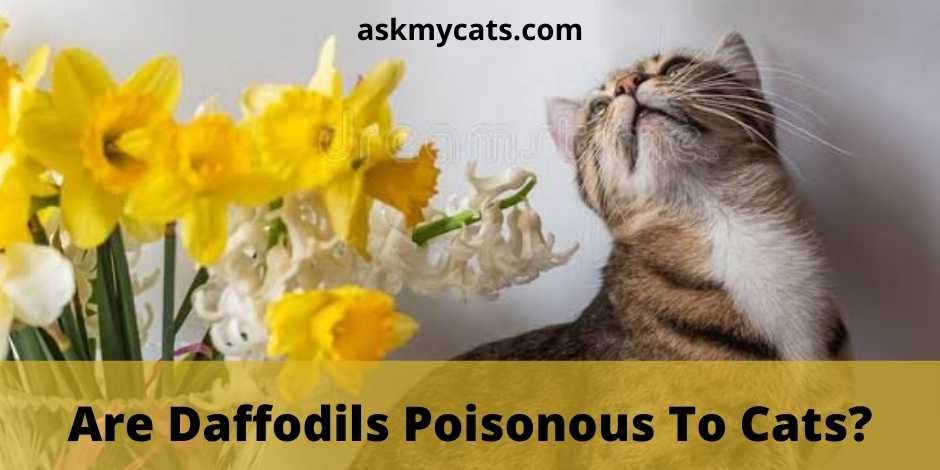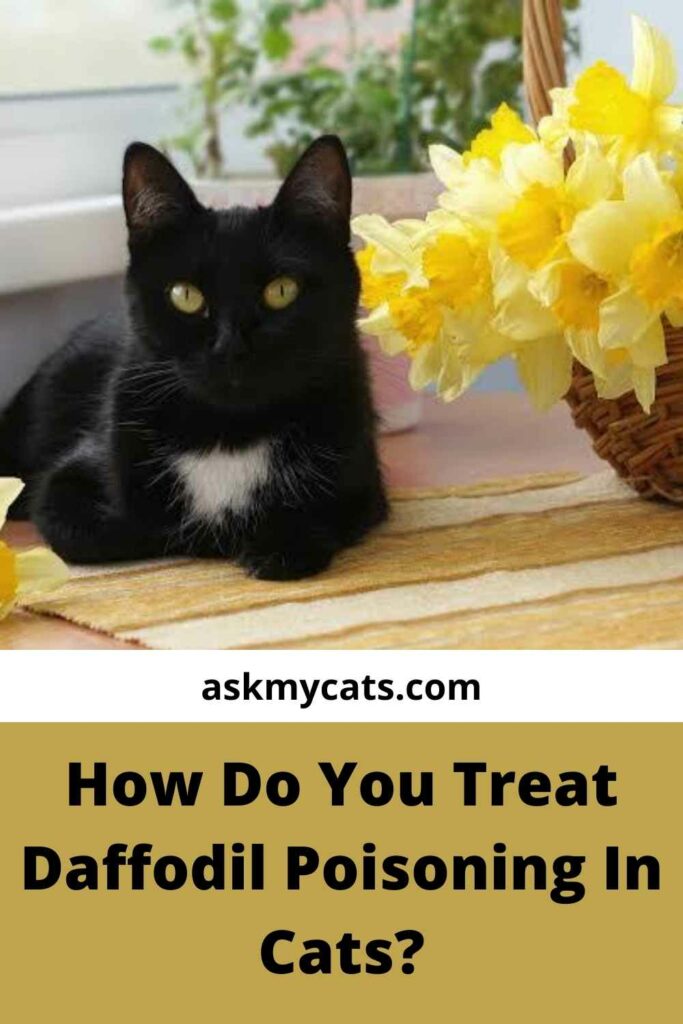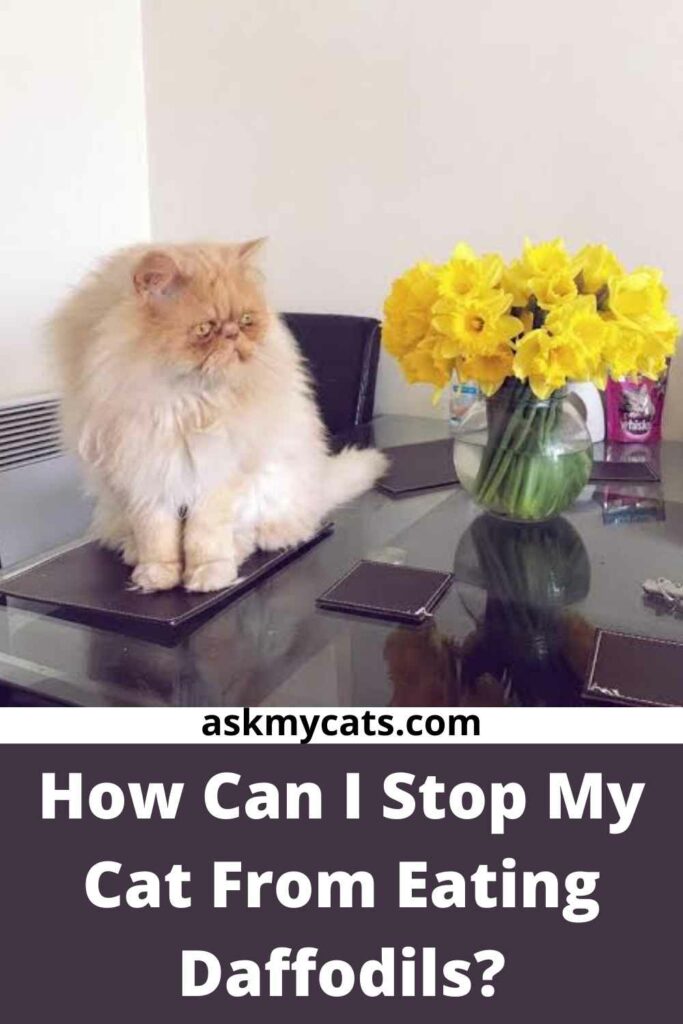Daffodils are colorful blooming bulbs with the scientific name Narcissus. During spring, these incredibly low-maintenance plants appear. The Amaryllidaceae family includes daffodils.
Maybe you’re worried your cat ate a daffodil or perhaps you intend to grow daffodils or bring daffodils into your home. We are here to help inform you about the relationship between daffodils and cats to the best of our abilities.
Yes, cats are poisoned by daffodils. The entire plant, as well as the bulb, is toxic to cats. This is because daffodils contain a substance called lycorine, which causes harmful effects on cats.
Keep reading to learn more about the relationship between daffodils and your feline companion!


Give Your Cat the Perfect Day
Get the Free Ebook!
Can Daffodils Harm Cats?
Daffodils are deadly to cats, but they are also dangerous to other animals like horses and dogs.
The entire plant, especially the bulb, is poisonous. Be cautious if your cat eats any part of the plant, especially the bulb, since it may cause serious poisoning.
Lycorine, an alkaloid with severe emetic effects, is found in these flowers. Lycorine is a substance that triggers vomiting.
Crystals, similar to hyacinths, are present on the outer layer of the bulbs, causing significant tissue irritation and subsequent drooling.
Shivering, low blood pressure, convulsions, diarrhea, excessive drooling, vomiting, nausea, stomach discomfort, labored breathing, and cardiac arrhythmia can all result from ingesting any part of the plant.
If you have any cause to believe your cat ate any part of a daffodil, we recommend that you get emergency veterinary help for them before you see any of these symptoms.
What Happens If A Cat Eats A Daffodil?
Daffodils are harmful to cats, according to the ASPCA. These flowers, as lovely as they are, can cause significant issues if swallowed by your pet.
Crystalline lycorine, an alkaloid that produces vomiting if ingested, is the toxin found in these low-maintenance plants. Lycorine may be found in all sections of the daffodil, although it is concentrated most heavily in the bulbs.
As a result, even though your cat is prohibited from eating the entire plant, the bulb is by far the most poisonous component.
Furthermore, needle-like calcium oxalate crystals found in the outer layer of a daffodil bulb might irritate cats’ skin and induce drooling.
What Do I Do If My Cat Eats A Daffodil?
Do not be alarmed if your cat eats daffodil. Keep in mind that veterinarian help isn’t always necessary in these situations, especially if your cat just ate a little bit of the plant. Maintain your composure and remove any plant debris from your cat’s mouth or fur.
Even though daffodil poisoning in cats is seldom deadly, you should contact your veterinarian for further advice. If therapy is necessary, it is preferable to begin it as soon as possible.
If possible, tell your veterinarian where part of the daffodil your cat ate and how much. Bring a sample of the plant into the clinic to assist your veterinarian in determining its level of toxicity.
Your veterinarian may give medicine to make your cat vomit if she has daffodil poisoning. Toxins can also be moved through your cat’s digestive tract with activated charcoal. If your cat has been vomiting a lot, she may need IV fluids to help her recover from dehydration.
Can A Cat Die From Eating A Daffodil?
Daffodils are certainly toxic to cats, according to the ASPCA. The weeds are poisonous not just to cats, but also to other animals.
The plant’s alkaloids, especially crystalline lycorine, are the most dangerous components. The toxic lycorine found in daffodil bulbs is toxic.
If your darling kitten eats any part of the plant, especially the bulbs, she may not die but it may be poisonous for her, so be careful.
What Part Of The Daffodil Is Poisonous To Cats?
The entire plant, especially the bulb, is poisonous. Be cautious if your cat eats any part of the plant, especially the bulb, since it may cause serious poisoning.
Lycorine, an emetic, is found in daffodils. Toxins are available in all sections of the plant, however, the bulbs are the most deadly.
Crystals on the outer layers of daffodil bulbs are extremely dangerous to cats if eaten. Poisoning from daffodils needs medical attention. Therefore, don’t hesitate to contact your veterinarian.
What Are The Symptoms Of Daffodil Poisoning In Cats?

In cats, daffodil poisoning manifests itself in a variety of ways. Shivering, low blood pressure, seizures, diarrhea, excessive drooling, vomiting, nausea, tissue irritation, fast heart rate, stomach discomfort, difficulty breathing, and cardiac arrhythmia are all warning symptoms of poisoning.
If you have any cause to believe your cat ate any part of a daffodil, get emergency veterinary help for her before you see any of these symptoms.
If your cat consumes the leaves, blooms, or pods of daffodils, it can cause stomach problems, vomiting, or even death.
The severity of daffodil poisoning varies from cat to cat, depending on how much and what portion of the plant was consumed.
Poisoning symptoms might develop as quickly as two hours after ingestion.
The American Society for the Prevention of Cruelty to Animals (ASPCA) recommends pet owners keep an eye out for the following clinical symptoms of daffodil poisoning:
- Vomiting
- Abdominal pain
- Diarrhea
- Drooling
- Salivation
- Labored breathing
- Lethargy
Low blood pressure, tremors, and cardiac rhythms may occur if your cat consumes a substantial amount of the flower.
While it’s more frequent in humans who work with a lot of daffodils, some cats can also suffer skin responses to the flower. The plant’s calcium oxalate crystals, which are sharp particles that hurt the skin, can cause “daffodil pickers’ rash.” The sap of daffodil stems and bulbs contains the highest concentration of these crystals.
Symptoms will usually go away on their own within 12 to 48 hours. If you have reason to believe your cat has eaten a daffodil, don’t wait for symptoms to emerge.
Act immediately and consult a veterinarian.
How Do You Treat Daffodil Poisoning In Cats?

The first thing the professionals at the vet will want to do when you bring your cat in takes her vital signs to check how she’s doing. They’ll also want to know what she ate and how much she ate if such information is available.
The vet will very certainly collect a history of your cat’s health and habits, not simply the events leading up to the appointment. Things will probably go well if your cat is in generally good health.
However, if your cat has another health issue, you should notify your veterinarian so that it may be considered during therapy.
The vet will almost definitely recommend intravenous fluids for your cat. This is to replenish the fluids lost when your cat was ill or diarrhoeic. The extra fluids will also aid in the removal of all poisons from your cat’s body.
If there are still fragments of daffodil in your cat’s stomach, activated charcoal preparations may be administered to prevent her from absorbing further toxins.
Your cat’s vet may also need to give her medication to counteract the daffodil poisons. These medications will help your cat’s heartbeat more consistently while also stimulating her central nervous system.
Your cat may become severely hypothermic as a result of her low blood pressure, which your veterinarian will treat by keeping her warm.
All of this might be frightening and difficult for your cat, but it is necessary. These therapies will keep her alive till the toxin has passed through her system and will aid in her recovery.
You may need to take your cat to the clinic for a few days if the poisoning is serious. The good news is that most cats recover quickly after receiving therapy.
How Can I Stop My Cat From Eating Daffodils?

Daffodils are seldom cultivated inside, which is excellent news. Because they’re generally an outside plant, keeping your cat away from them is simple.
Daffodils are occasionally brought into the home as cut flowers, and an inquisitive kitty will try them. It isn’t much you can do to keep cats from chewing on objects that seem appetizing, other than putting them in an area where the cat isn’t permitted to go.
Poisonous plants can be hung from the ceiling or placed on a table surrounded by a surface the cat doesn’t like to tread on, according to some cat owners.
In general, we recommend keeping toxic plants out of the reach of cats. Even if you manage to keep the pot or vase out of the cat’s reach, parts of the plant can fall out and be eaten.
Daffodil bulbs should be kept away from cat food, kitten snacks, and other items that she might like to consume. If you don’t have access to a shed, store spring bulbs in a sealable container or a cabinet that your cat can’t enter until they’re ready to use.
Separating daffodil bulbs from edibles also helps to prevent human poisoning.
What Are Some Cat-Friendly Alternatives To Daffodils?
Don’t panic if you prefer the cheery appearance of daffodils as there are lots of safer alternatives. These flowers not only pass the cat test, but they’re also gorgeous and fragrant.
The following are some of our favorite cat-friendly plants:
- Gerbera Daisy
- Orchid
- Rose
- Snapdragon
- Limonium
- Waxflower
- Freesia
- Sunflower
- Zinnia
- Bromeliads
- Lipstick plant
Finally, as cat owners, it is our obligation to maintain our homes free of hazardous plants and other poisons. It’s a good idea to start by learning which plants are harmful to animals.
Frequently Asked Questions
Are Daffodils Edible For Cats?
No, daffodils are not edible for cats as it is poisonous to them. While the toxicity of these flowers is modest to moderate, it’s better to keep them away from your curious cat.
What Flowers Are Safe For Cats?
Cats may eat alstroemeria, asters, gerber daisies, orchids, and roses.
What Happens When A Cat Eats Daffodil?
Daffodil poisoning develops quickly, and the symptoms can be quite severe. Vomiting and diarrhea may be experienced by the cat.
Final Words
Nothing brings more color to your home than a bouquet of freshly cut flowers. They provide a warm welcome to any home.
Cat owners should be warned, however, that those gorgeous blooms may be harmful to cats.
If your cat consumes the leaves, blooms, or pods of daffodils, it can cause stomach problems, vomiting, or even death. If you have any cause to believe your feline ate any part of a daffodil, get emergency veterinary help for them before you see any of these symptoms.
Dropdown your queries and doubts regarding your feline companion in the comment section below.
